Pentax K200D
-
-
Written by Gordon Laing
Pentax K200D Studio resolution / JPEG and RAW results
Pentax K200D results continued…
| Support this site by shopping via these links | ||||||||||||||||||||||||||||||||||
 |
To measure and compare the Pentax K200D’s resolving power we photographed the Enhanced Digital Camera Resolution Chart with it and a number of rival models, each using their best quality JPEG and default image tone and sharpening settings. We tested the Pentax K200D with the DA 18-250mm; note this was the only lens Pentax had available for our review. We tested it at all apertures and selected the sharpest result. The crops are taken from the original images, saved as High Quality JPEGs in Photoshop CS2 and presented here at 100%. Each number represents 100 lines per picture height (lpph), so a figure of 20 means a resolution of 2000 lpph. |
Fitted with the Pentax DA 18-250mm lens at 35mm f8, the K200D resolved 2050 and 2100 lpph of horizontal and vertical resolution respectively. The Sony Alpha DSLR A300 shares the same 10.2 Megapixel resolution, but managed to deliver fractionally greater horizontal resolution with its DT 18-70mm kit lens. The Olympus E-520 may also have 10 Megapixels, but by arranging them in a narrower frame, it has a slightly higher concentration over the target area and subsequently delivers slightly higher scores in this test. Finally, the Canon EOS 450D / XSi takes the lead here with its 12.2 Megapixel resolution. The Pentax K200D shares the same sensor and image processor as the earlier K10D, so it’s not surprising to find similar scores in this test. In our K10D review, it scored 2050 and 2150 lpph when fitted with the DA 18-55mm lens. So the K200D in our studio JPEG resolution test performs as we’d expect for a 10 Megapixel DSLR. While the JPEG results below show the usual fuzziness once the moiré kicks-in, it’s possible to achieve much higher extinction resolutions when shooting in RAW – scroll down to the bottom of the page to see an example, or head straight over to our Pentax K200D noise results page where we’ll see how it performs across its sensitivity range next to the Canon 450D / XSi and Olympus E-520. |
Pentax K200D with Pentax DA 18-250mm |
Canon EOS 450D / XSi with EF-S 18-55mm IS | |
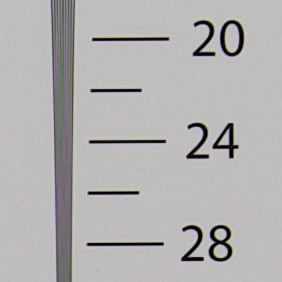 | 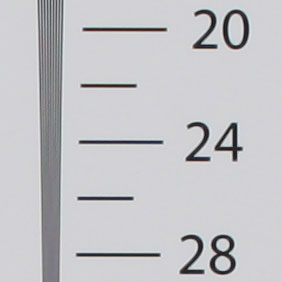 | |
2050 lpph, 18-250mm at 35mm, f8, 100 ISO |
2200 lpph, EF-S 18-55mm IS at 35mm, f8, 100 ISO | |
Olympus E-520 with Zuiko Digital 14-42mm ED |
Sony Alpha DSLR-A300 with DT 18-70mm | |
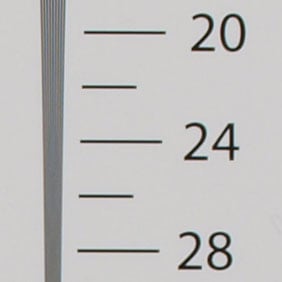 | 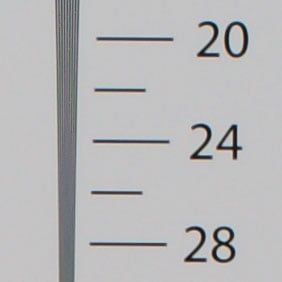 | |
2150 lpph, 14-42mm at 25mm, f8, 100 ISO |
2100 lpph, DT 18-70mm at 35mm, f8, 100 ISO |
Pentax K200D with Pentax DA 18-250mm |
Canon EOS 450D / XSi with EF-S 18-55mm IS | |
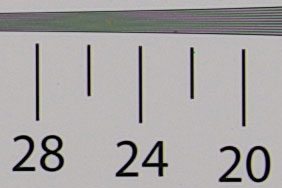 | 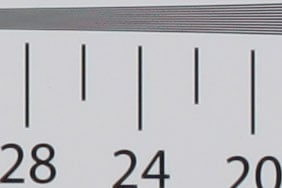 | |
2100 lpph, 18-250mm at 35mm, f8, 100 ISO |
2225 lpph, EF-S 18-55mm IS at 35mm, f8, 100 ISO | |
Olympus E-520 with Zuiko Digital 14-42mm ED |
Sony Alpha DSLR-A300 with DT 18-70mm | |
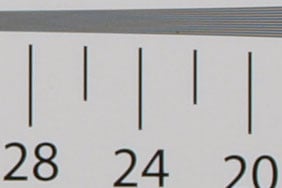 | 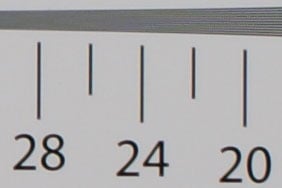 | |
2150 lpph, 14-42mm at 25mm, f8, 100 ISO |
2100 lpph, DT 18-70mm at 35mm, f8, 100 ISO |
Pentax K200D Studio resolution: JPEG versus RAW
We photographed the test chart in the K200D’s RAW (DNG) plus *** 10M JPEG mode, allowing us to directly compare images created from exactly the same data. Below are crops taken from the original JPEG file alongside the RAW version, processed in Adobe Camera RAW.
It’s immediately apparent how the processed RAW file resolves greater detail in this test, comfortably scoring 2250 lpph of horizontal and vertical resolution before moiré kicks-in. But while many cameras would then descend into fuzziness, the K200D’s RAW files still show resolvable detail beyond 2400 lpph. It may be possible to improve the JPEG resolution results by tweaking the in-camera settings, but it’s clear that shooting in RAW can deliver significant resolution benefits.
Now let’s check out the camera’s performance at different sensitivities in our Pentax K200D noise results page.
Pentax K200D JPEG with Pentax DA 18-250mm |
Pentax K200D RAW with Pentax DA 18-250mm | |
 | 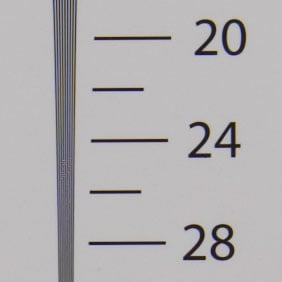 | |
2050 lpph, 18-250mm at 35mm, f8, 100 ISO |
2250 lpph, 18-250mm at 35mm, f8, 100 ISO |
Pentax K200D JPEG with Pentax DA 18-250mm |
Pentax K200D RAW with Pentax DA 18-250mm | |
 | 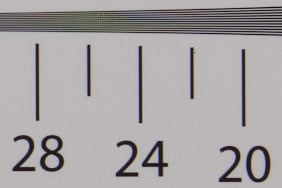 | |
2100 lpph, 18-250mm at 35mm, f8, 100 ISO |
2250 lpph, 18-250mm at 35mm, f8, 100 ISO |




